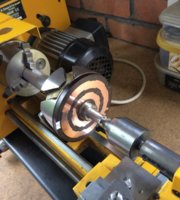I have made several comments regarding low voltage from my alternator in the following thread (See mainly Page 2 of thread):
http://www.xs650.com/threads/well-that-didnt-last-long.52169/page-3#post-550808
The situation is that the voltage output from my alternator is low and the observation is a weak rotor magnetic field. I have spent considerable time trying to resolve the problem and have determined that my SH is electrically sound. The issue is poor conduction through the brushes and rotor even though the rotor is perfectly functional as with all the electrical wiring, connectors and the Rec/Reg (See the link above for details).
When I measured the resistance of the brushes and rotor assembled combined I observed 14 Ohms. I know that each brush contributes approximately 0.1 Ohm and the rotor is 5.3 Ohm. Therefore something else is offering a resistance and this has to be the copper/brush contact.
I have sanded the copper rings lightly as well as the ends of the brushes. On reassembly the combined resistance returned to essentially that of the rotor plus brushes. I started the engine up and all is good with the regulator controlling at its preset of 14.2V. I headed off on a 20 mile ride and all was well for the first 10 miles and then the voltage started to drop to a low level as in the past.
What is contaminating the brush/copper contact point?
The only explanation I can think off is oil vapors are leaking from the crank seal. I cannot see any obvious sign of oil leaking and the oil seal was replaced a couple of months back when I fitted the new rewound rotor.
Has anyone had a similar experience like this??
Thank you for any thoughts and suggestions, but bear in mind that all the electrical testing has passed.
http://www.xs650.com/threads/well-that-didnt-last-long.52169/page-3#post-550808
The situation is that the voltage output from my alternator is low and the observation is a weak rotor magnetic field. I have spent considerable time trying to resolve the problem and have determined that my SH is electrically sound. The issue is poor conduction through the brushes and rotor even though the rotor is perfectly functional as with all the electrical wiring, connectors and the Rec/Reg (See the link above for details).
When I measured the resistance of the brushes and rotor assembled combined I observed 14 Ohms. I know that each brush contributes approximately 0.1 Ohm and the rotor is 5.3 Ohm. Therefore something else is offering a resistance and this has to be the copper/brush contact.
I have sanded the copper rings lightly as well as the ends of the brushes. On reassembly the combined resistance returned to essentially that of the rotor plus brushes. I started the engine up and all is good with the regulator controlling at its preset of 14.2V. I headed off on a 20 mile ride and all was well for the first 10 miles and then the voltage started to drop to a low level as in the past.
What is contaminating the brush/copper contact point?
The only explanation I can think off is oil vapors are leaking from the crank seal. I cannot see any obvious sign of oil leaking and the oil seal was replaced a couple of months back when I fitted the new rewound rotor.
Has anyone had a similar experience like this??
Thank you for any thoughts and suggestions, but bear in mind that all the electrical testing has passed.

